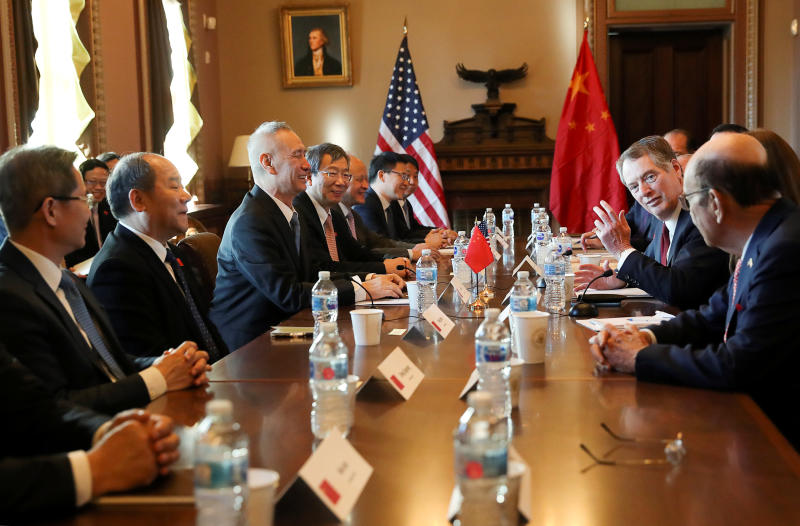US President Trump to meet China's top trade negotiator Liu He on final day of talks
Sign up now: Get ST's newsletters delivered to your inbox

US Trade Representative Robert Lighthizer will lead a second and final day of negotiations with Chinese Vice-Premier Liu He on Jan 31, 2019.
PHOTO: REUTERS
Follow topic:
WASHINGTON (BLOOMBERG, REUTERS) - US President Donald Trump will meet China's top trade negotiator in the Oval Office later on Thursday (Jan 31) for high-level talks, with little indication that Beijing will bend to American demands to deepen economic reforms.
US Trade Representative Robert Lighthizer will lead a second and final day of negotiations with Chinese Vice-Premier Liu He, the highest-level talks since Trump met Chinese President Xi Jinping on Dec 1 and declared a 90-day truce to reach a lasting deal to end the trade war. Trump is scheduled to meet Liu at 3.30pm US time (4.30am Singapore time), according to an e-mail of his schedule from the White House.
While a breakthrough deal is seen as unlikely from this round of negotiations, the White House has said a concluding statement will be released on the progress they've made on core issues such as Chinese technology transfers and intellectual property practices, market access and Beijing's pledge to buy more American goods.
Stocks in Asia and Europe advanced on Thursday, following gains in the US on Wednesday. The S&P 500 reached the highest since Dec 6, after the Federal Reserve said it will be "patient" on any future interest-rate moves.
Fed Chairman Jerome Powell on Wednesday expressed concern that prolonged negotiations could cause further uncertainty for investors. "The concern is a longer drawn-out set of negotiations, which could result in sapping business. Uncertainty is not the friend of business," Powell said in response to a question during a press conference.
The talks began with an awkward silence on both sides of a long negotiating table during a photo opportunity, broken when Lighthizer made joking remarks about table positioning and appearing in photographs of a dinner between Trump and Chinese Xi in that December meeting.
Seated next to Liu was People's Bank of China Governor Yi Gang, a reform-minded official who has advocated further opening of China's financial services markets, with officials from the Finance and Commerce ministries also present.
But details of Wednesday's closed-door talks were scant, with official statements seen as unlikely before they conclude.
Unless a deal is reached by March 1, the US has threatened to raise tariffs on US$200 billion (S$269.2 billion) worth of Chinese products to 25 per cent from 10 per cent.
Administration officials and other people familiar with the state of play say the two sides remain far apart on key issues, with the US side still engaged in an internal debate over how to proceed and ill-prepared for this week's meetings.
The US's unveiling this week of criminal charges against Chinese corporate giant Huawei Technologies isn't helping the mood.
The last round of US-China talks led by Deputy USTR Jeffrey Gerrish in Beijing earlier this month ended with no progress on IP practices and technology transfer issues, which are Washington's main concerns in the trade war that has roiled financial markets for months. China did offer at that meeting to go on a six-year buying spree to ramp up imports from the US, which was met with scepticism from the Trump administration.
In a sign that Beijing is serious about addressing US complaints, Chinese lawmakers this week completed a second review of a new law that is aimed at protecting the IP of foreign investors and banning forced technology transfers.
But US business groups said the draft law will not address the real regulatory issues of concern where forced technology transfer is occurring in the Chinese system. Another longstanding concern with Chinese laws is the breadth and scope of the national security review, the US Chamber of Commerce, AmCham China and AmCham Shanghai said in comments submitted on the Bill.
ECONOMIC IMPACT
Trump this month said that China's slumping economy gave the country no choice but to make serious commitments. "China posts slowest economic numbers since 1990 due to US trade tensions and new policies," Trump said Jan 21. "Makes so much sense for China to finally do a Real Deal, and stop playing around!"
But the impact of Trump's trade policy is also being felt by the US. The non-partisan Congressional Budget Office on Monday said it expected that Trump's tariffs on steel, aluminium, and Chinese goods would cut the US real gross domestic product by at least 0.1 per cent on average through 2029. It also predicted overall US GDP growth would slow to 2.3 per cent this year, 1.7 per cent in 2020, and 1.6 per cent in 2021.

